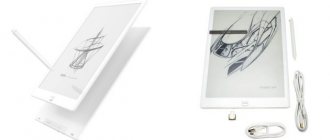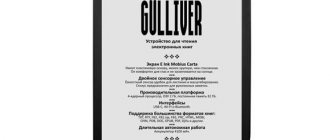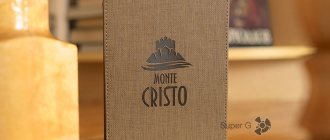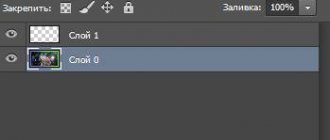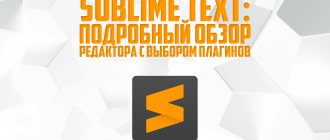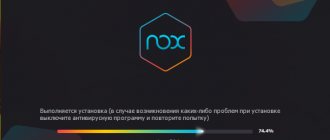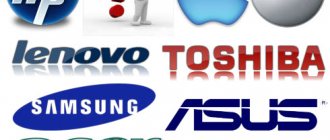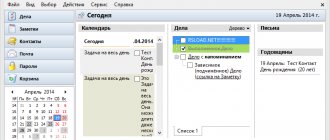Positioning
The vast majority of E Ink readers on the market today are 6-inch. They are small, compact, and can be easily grabbed with your hand from behind. It would seem, is it possible to achieve the same operating comfort by equipping the model with a 7.8-inch diagonal screen? The answer suggests itself: it’s impossible. But PocketBook proved the opposite - it’s very possible! PocketBook 740 is perceived as a compact e-reader, although in fact we are dealing with a large-format model. Little big reader - you couldn't say it better!
Comparison of dimensions of PocketBook 740 (7.8 inches) and PocketBook 626 Plus (6 inches)
The PocketBook 740 display area was increased due to the frames - they were simply made much thinner. Yes, yes, one of the latest trends in the “smartphone” industry - the reduction of frames (or even their complete elimination) - has successfully migrated to the world of electronic readers. In addition, it was possible to increase the diagonal of the display by reducing the block of control keys. This block has turned from a noticeable elongated rectangle into an elegant narrow line.
To be fair, it is worth noting that the PocketBook 740 is still slightly larger than its 6-inch relatives - slightly longer and slightly wider. But don’t look at the photographs, but take our word for it - in practice (which is most important!) the difference is almost imperceptible. The hero of the review weighs only 210 g. It is quite difficult to compare it with absolute analogues, due to the virtual absence of them on the market. Well, there are no 7.8-inch e-readers for sale, what can you do! But there are 8-inch readers, which are on average one and a half times heavier than the PocketBook 740 - at least 300 g. And much wider. In comparison with them, the new pocketbook looks much more elegant and feels much nicer in the hand.
Well, a few words about the price. PocketBook 740 costs about 14,500 rubles. We remind you that this amount will have to be paid for a super-sophisticated large-format flagship reader. For comparison: the same 8-inch PocketBook 840 Ink Pad 2, the successor (albeit very conditional!) of which the PocketBook 740 is actually, cost 17,500. And one more important point: the PocketBook 740 is by far the most affordable large-format reader on the market. There are virtually no models with a screen larger than 6 inches that would cost less.
Technical content and autonomy
Let's start with memory for files, books, photos and documents - both devices have 16 GB of internal memory, but the AirBook PRO 8S also supports a microSD card, with which you can increase the available capacity by another 128 GB.
Let's consider the RAM, on which the performance of the device depends. The AirBook PRO 8S wins here too, as it has 2 GB, which is twice as much as its competitor. The same situation with the processor - eight-core
Rockchip 3368 Octa-Core 1.5GHz in the Ukrainian reader versus two cores and 1 GHz in the PocketBook 740 Pro.
Despite its lighter weight, AirBook PRO 8S has a Li-Polymer battery with a capacity of 3100 mAh. Although this is almost twice as large as the PocketBook 740 Pro and its 1900 mAh, the operating time of the devices is almost identical (about a month on one charge), since the AirBook consumes more energy.
Both readers have smart screen backlighting that adapts to lighting and time of day. At night, the screen will glow with a pleasant warm color, allowing you to fall asleep immediately after reading a chapter of your favorite book.
Both AirBook PRO 8S and PocketBook 740 Pro have Bluetooth and Wi-Fi connectivity. The first will allow you to connect the device to a speaker or headphones to listen to audio, and the second opens up unlimited possibilities for downloading books and files directly from the Internet.
Results:
Each reader has good technical content, tailored to its needs. Although the AirBook PRO 8S has almost twice the performance, the PocketBook 740 Pro does not perform significantly worse or slower due to its simplicity and not so advanced functionality. If you find fault with the hardware, the e-reader from AIRON is the clear leader.
Appearance and Controls
PocketBook has always gravitated towards the classics in the design of its readers. Laconic, ergonomic devices, with excellent build quality - there seems to be no need to go beyond these limits. Therefore, many pocketbooks from previous years look similar to each other. PocketBook 740 is the company’s first reader in several years with a completely new design. And this design will apparently be used in future models of the brand.
What's new? As already mentioned, the frames have become much thinner. Plus, the appearance of the function keys has been updated - they fit organically into the overall concept of the new pocketbook and generally look more aesthetically pleasing. Despite the fact that the buttons have become smaller, controlling the reader with their help is still just as convenient. The number of buttons remains unchanged - there are still four of them: “home”, two keys for scrolling (back and forth in the book) and calling up the menu.
As with all pocketbooks, it provides the ability to reassign functions and assign actions to a long press.
The convenient location and distance of the buttons from each other (despite the fact that they are made as a single unit) practically eliminate accidental presses. You can control the reader either using these same buttons or by touching the touch screen - whichever is more convenient for you.
The body of the device is made of hard brown plastic. The material is quite pleasant to the touch and not at all slippery.
In this model, the developers abandoned one ergonomic element implemented in almost all pocketbooks of the previous generation - a special protrusion for the index or middle finger on the back panel of the device.
But it must be said that even without the protrusion, the PocketBook 740 lies quite securely in the palm of your hand and does not slip out.
At the bottom there is a power key, a MicroUSB port and a MicroSD card slot.
You won't find a headphone jack for a simple reason - there are no audio capabilities in the PocketBook 740. So you won’t be able to listen to music or an audiobook on it. For these purposes, there is the PocketBook 631 Touch HD (12,000 rubles) or PocketBook 631 Plus (12,500 rubles), which also support Text-to-Speech (reads books out loud). The new product, alas, also did not receive total water protection - all the laurels of the only truly waterproof pocketbook in the world still remain with the PocketBook 641 Aqua 2 (10,500 rubles).
Design and ergonomics
Externally, there are no differences between the Pro version and the regular one; the gadgets are as similar to each other as two peas in a pod. The only exception is that the older version has only one color - silver, while the younger brother has two color options - black and gray.
The device looks modern and stylish due to the miniature frames near the screen. They also helped make the gadget compact with a relatively large display. This is one of the trump cards of the review hero, which allows him to look better than his competitors when compared. Unlike other models with a similar screen diagonal, the Pocketbook 740 Pro can be easily grasped from behind with your hand.
In terms of weight, everything is also great - 215 grams. Note that many 6-inch readers weigh about the same. Due to its lightness, the gadget is convenient to use and even after long reading sessions your hand does not get tired of it. Taken together, all this makes the model one of the best on the market in terms of ergonomics.
At the bottom of the display there are mechanical keys with which you can control the reader. Many users liked this even during the presentation. There are four elements in total: the first is responsible for exiting to the main screen, the second and third are for turning pages, and the last one calls up the context menu. Each of their buttons has good travel and feedback. It is noteworthy that the gadget allows the owner to reconfigure the keys and assign functions to long and regular presses.
If you prefer to turn pages using the sensor, you can simply click on the right or left side of the screen, depending on where you want to move.
One of the key innovations of the model is water protection according to the IPX8 standard, which the regular version does not have. This makes it the only e-reader on the market with a large display and water resistance. Other points worth mentioning are the recessing of the display into the body. This is important because if the reader falls, it will not land on the screen, but on the plastic frame, which will protect the glass from damage.
The body is made of matte plastic, pleasant to the touch. The surface does not mark, does not collect fingerprints and dirt, so the reader can be safely used without a case. In addition, if you do get the lid dirty, you can wash it under the tap.
On the bottom edge there is a power key and a microUSB port. The first element contains an LED that lights up white when the reader is operating. It is noteworthy that the microUSB connector is needed not only for connecting the gadget to a PC or charging, but also for connecting headphones. For this purpose, a special minijack adapter is supplied in the kit.
An incomprehensible decision on the part of the developer was the refusal of a slot for a flash drive, which the Pocketbook 740 has. This cannot be considered a significant drawback, because the built-in 16 GB is enough for the owner.
Display and backlight
The E Ink Carta display technology used in the new flagship PocketBook is the latest. The screen resolution is the highest by the standards of readers - 1872 × 1404 pixels. For example, the 8-inch PocketBook 840 Ink Pad had 1600 × 1200 pixels. And for 6-inch readers, the ceiling is 1448 × 1072 pixels. If you look at the sparsely presented 9.7-inch models on the market, we generally see a maximum of 1200 × 825 pixels.
So, we repeat, the resolution of the PocketBook 740 is very, very high. This is expressed in the almost printing quality of the text - even material with a large number of small characters can be easily read. Without any difficulties, you can examine in detail the graphs, diagrams, tables, which are abundant in educational, scientific, technical and business literature. Overall, the PocketBook 740 screen is the best display we’ve ever seen in a reader.
The backlight of the PocketBook 740 is implemented in an extremely interesting way. Namely: the model allows you to adjust the color temperature of the backlight. By the way, the same function is also available on the PocketBook 631 Plus, released at the end of 2017. Why is this feature needed at all? Let's explain. The usual backlighting of reader screens is white. And if during the day cool colors (and white is just cold) practically do not tire the eyesight, then for reading in the dark they are much less pleasant than warm ones. The warmer the glow, the less tired your eyes are and the more you fall asleep. And it works especially effectively in the absence of additional light sources.
The ability to finely adjust the shade allows the user to choose the backlight that is comfortable for his eyes. The shade scale starts with white and ends with orange. In between there are a lot of yellow variations. With each movement of the slider to the right, the color temperature becomes more intense. This is what this scale looks like on the reader screen (second from the top):
In this case, you don’t have to set the backlight color manually, but use the automatic mode. When activated, the backlight color will be set depending on the time of day. That is, for example, at 9 am the screen backlight will be white, at 9 pm - yellow, and at night it will turn orange. Similarly, the brightness can be automatically adjusted.
In addition, there is a new function for setting backlight patterns. For example, you can set the yellow backlight every day from 13:00 to 18:00. And after six in the evening it will have to change to orange, and remain like that until 13:00 the next day. If you wish, you can set your own color and brightness for each hour, set a specific gamma for each day of the week, and even switch between created templates.
In general, adjusting the backlight color temperature is a very interesting and useful function. And few readers have it yet. Moreover, there is one important nuance. PocketBook models use a proprietary development from E Ink to adjust color temperature. But the vast majority of readers from other brands use a homemade Chinese analogue of this technology. The difference between these lighting options, as you probably already guessed, is huge. The Chinese screen backlight with color temperature adjustment “eats” the charge a third more actively than a single-color backlight. As a result, the device discharges 30% faster. But the “native” adjustable backlight from E Ink, which is used in the PocketBook 740, does not differ at all in terms of the amount of energy consumed from a single-color one.
It remains to be said about the built-in cover sensor: PocketBook 740 automatically enters and exits standby mode, reacting to the opening and closing of the cover cover.
Design, construction and control
It's not very often that PocketBook creates a completely new design for its readers. For example, many current brand models still use developments first implemented in. I don’t consider this a serious problem: if you have already managed to create a good and ergonomically thought-out design, then why change something very often? These are not smartphones: the design there must change constantly so that those around you immediately realize that you have the latest model (which means you’re cool, yeah). With e-readers everything is different.
However, in PocketBook 740 we just see a completely new design, which will probably become the base for all PocketBooks of the 2020 model.
What has changed? The frames have become much thinner, as I already mentioned above. I will also note the new shape of the control keys. If in previous models they were, roughly speaking, square, now they are thin “rectangles”. This did not affect the ergonomics in any way, but the keyboard unit was made much more compact. And due to this, install a larger screen. If the block were larger in height, the display would be, say, 7 inches.
I like the new design - it’s so fast-paced. Less calm than previous models. And all because of the shape of the buttons.
++++ sidebar for Kindle fans ++++
I have read more than once in the comments that PocketBook, they say, “has no design.” It is clear that beauty is a very subjective concept, and yet: PocketBook 740 is noticeably prettier than previous models, I believe that the company wisely chose the new corporate style of its models. The same Amazon Kindle may be attractive in its own way. In my opinion, they don’t have any design at all, but ok, everyone has different preferences. Some people like the tone - and that’s great.
However, if we regard design not only as appearance, but as a combination of attractiveness and convenience, then I cannot praise the Kindle. I recently played with the Kindle Oasis in my hands. Yes, the metal back panel is definitely a good solution. But that’s all: the shape of the body, sorry, is kind of strange. Personally, I find it convenient to hold the Kindle Oasis with only one hand—the right. That is, we are no longer talking about universality. There are buttons (hurray, since other Kindles, as a rule, do not have them at all), but only two, and not four, like the PocketBook 740. So... Some people like one thing, others another. For example, blondes and brunettes. Same with readers. But, in my opinion, at this stage there are still more arguments in the debate “who has a better and more convenient design” for PocketBook models than for Kindle models.
++++ end of sidebar for Kindle fans ++++ Let's return to the ergonomics of the PocketBook 740: the buttons are pressed easily, but not so much that accidental presses occur. The keys are made of plastic with rubber coating. There are traditionally four of them: two for turning pages, “home” and calling the menu. As in previous pocketbooks, the keys can be reassigned and functions can be set for a long press.
The case material is slightly rough plastic of brown-golden color. I would like to draw special attention to the fact that, despite the large area of the body, its rigidity will be fine. I tried to twist and bend the PocketBook 740 (within reasonable limits, of course), and nothing happened to it. There weren't even any creaks, not to mention any breakdowns.
The back panel is completely flat. That is, there is no protrusion for the finger, which was in almost all pocketbooks of the previous generation. I'm talking about him - see below (photo from the review).
In my opinion, the ledge could have been left. On the other hand, even without it there are no problems holding the reader in your hand. You want to hold it by the side, or you want to hold it by the corner of the case. PocketBook 740, let me remind you, weighs 210 g, so it doesn’t weigh on your hand.
The cover sensor is built into the case. If you buy this accessory along with the reader, then when you close the lid, PocketBook 740 will automatically fall asleep, and when you open it, it will wake up.
It remains to be said that on the bottom edge there is a MicroUSB port, a backlit power button (if desired, the backlight can be deactivated in the settings) and a slot for MicroSD cards.
Does something seem missing? That's right: a headphone jack. Because there are no audio capabilities in PocketBook 740. This is perhaps its only “technological” minus. That is, everything else is implemented at the highest level, but without music. And, by the way, without water protection. For total water protection - to (10,900 rubles), and for music and Text-to-Speech - to (12,900 rubles), the flagship of the end of 2017. It can play MP3s and read texts with your voice.
Personally, I find the lack of a player in the PocketBook 740 a disadvantage, but in general there are quite a few like me. This is evidenced by a survey conducted - only 27.7% of respondents voted for audio capabilities, but 72.2% were in favor of the fact that they are superfluous in the reader.
Platform and software
PocketBook 740 is the first pocketbook with a dual-core processor and 1 GB of RAM, making it the fastest in the brand’s line. And, most likely, in the market in general.
According to the developers, it is at least 40% faster than previous models. In our opinion, the developers never exaggerate - there really is an increase, and sometimes it is much more noticeable than 40%. Switching on with book loading occurs in 3-4 seconds instead of 15 for previous models. PocketBook 740 opens “heavy” files (for example, PDF with a volume of 30-40 MB) in 5 seconds (for other readers this process takes 20 seconds).
Another advantage that has appeared in the reader thanks to the new dual-core processor is smooth rendering. This means that browser pages and “long” documents scroll without any delays or jerks.
Surprisingly, for all its speed, the “little big pocketbook” is record-breakingly economical in terms of energy consumption. The dual-core processor has significantly reduced energy costs, and this despite the impressive size of the display. For comparison: 6-inch readers can easily go without charging for about three weeks using the backlight, without it - about four weeks (you can read 8,000 pages). But the PocketBook 740 will last twice as long without charging - up to two months without backlighting and about a month and a half with regular use of the backlight. On one charge, you can read about 15,000 pages from the PocketBook 740 screen - today this is an absolute record in the reader market. Among any readers from any manufacturers.
Now about the software. PocketBook 740 runs on Linux, designed in Android style. In theory, understanding it is no more difficult than understanding a smartphone. A more or less advanced user should not have any problems managing the new pocketbook.
Well, the main “trick” of all pocketbooks, regardless of the model - omnivorousness in working with file formats - is also present here. PocketBook 740 supports PDF, PDF (DRM), FB2, FB2.ZIP, DOC, DOCX, RTF, TXT, HTML and so on, a total of 18 formats (readers from other brands support from 5 to 10 formats, no more). According to good tradition, PocketBook has pre-installed dictionaries - the translation is given after highlighting the word. There are four of them (dictionaries): English-Russian dictionary by Korolev, Webster's 1913, English-Russian and German-Russian from the PocketBook company.
The text display settings are also in order - a large selection of fonts, hyphens, line spacing, etc. There is a built-in gyro sensor - the image is reoriented horizontally or vertically in accordance with the position of the reader in space.
Network functions include the ability to download books to the device’s memory “over the air” via Dropbox or email. There is another option - buying literature from the largest online catalog in Russia, BookLand.com. In addition, there is a browser, an RSS reader, several games and an over-the-air firmware update function.
Little big reader. Review of PocketBook 740
The vast majority of modern e-book readers are made in the 6-inch form factor. This is a kind of standard for the market, formed ten years ago, at the dawn of the popularization of such devices. Everything would be fine, but for some users, the most demanding and advanced, 6 inches is clearly not enough. They would like a larger display, and with a higher resolution... To look at diagrams, graphs, charts, tables, and even sheet music. PocketBook has an answer to this sophisticated request. And this answer sounds like PocketBook 740 - a large-format 7.8-inch reader. Large format - but at the same time very compact. The 740 is, of course, larger than a typical 6-inch ereader, but not radically so. And this model can well be called the smallest large reader on the market - analogues with a diagonal of 7.8-8 inches are noticeably larger and heavier.
PocketBook 740 now costs about 16 thousand rubles. The same PocketBook has decent models priced at 7-10 thousand. However, they are all 6-inch. If we compare the prices of e-readers with a diagonal of around 8 inches, it turns out that the PocketBook 740 is just the cheapest. And at the same time perhaps the most technologically advanced.
Equipment
The model comes in a relatively small cardboard box. On the surface of the latter there is both a “portrait” of the reader and a list of characteristics in several languages. The delivery set includes a standard reader, USB cable, instructions, and warranty card. But what surprises is the warranty period - 3 years. Usually, electronics, including readers, are given only a year.
The kit does not include a case, and this is a minus. But, unlike most of its competitors, for which you won’t find cases during the day, PocketBook on its website store offers a lot of cases of different types, including for the hero of the review. Although you will have to fork out 1500-2000 rubles.
Appearance and ergonomics
Before us is a completely modern-looking reader with a large screen, very nice and neat, but at the same time really small. In a direct comparison, it turns out that the 7.8-inch 740 model is not much larger than the 6-inch Aqua.
The model turned out to be relatively miniature thanks to narrow frames on the left, right and top of the display. And the 740’s “beard” is also small. At the same time, the developers did not abandon hardware control keys, including a couple of buttons for turning pages. The fact is that today readers can be divided into two types according to the control method: push-button and touch, but models combining these two methods are not very common. In PocketBook, all touch readers have paging keys, as well as buttons to go to the desktop and call up the menu.
The keys on the PocketBook 740 are narrow - noticeably narrower than those on the same PocketBoo 641 Aqua 2. However, this has practically no effect on the ergonomics, and operating the 740 model is quite convenient.
Those who don't like the location of the scroll keys below the display can take advantage of touch controls by turning pages by tapping the screen on the left and right sides. And this is a completely worthy alternative to the keys, which in some readers are located to the left and right of the screen.
The screen is slightly recessed into the body. In my opinion, this is the right decision: E Ink screens have a bad reputation for not being the strongest screens, and breaking them is not so difficult, and this technical solution protects well from damage when falling the screen down.
Due to the plastic body, it was possible to achieve a low weight of 210 grams, which is even lighter than some 6-inch models. The surface is velvety. The assembly is very neat.
You can hold the device in various ways: by the corner, by clasping your hand from behind, by the side edge, and thanks to its light weight and dimensions, this is very convenient.
The MicroUSB port is used for charging; the power button and memory card slot are located on the bottom edge of the case. The slot does not have a plug, so I recommend sticking some kind of flash drive in there just in case, so that the slot does not become clogged with dust.
We tested a brown version of the PocketBook 740, but in nature there is also a black version.
Screen
The PocketBook 740 screen has several important features. In terms of usable area, the display of the 740th pocketbook seriously outperforms its 6-inch counterparts. The second important point is resolution. It is 1872 x 1404 pixels. Even by the standards of smartphones, this is a good resolution, and among readers this is almost a record, but the higher the resolution, the more comfortable it is to view PDF or DjVu files with graphs, diagrams, charts, tables and other complex layouts on the screen. Even very small numbers, symbols, and special signs are visible.
The matrix here is E Ink Carta, and it’s clearly first grade: no spots, dots, stripes or other artifacts. The backlight is also completely uniform, without overexposure or underexposure, and the maximum brightness allows you to use the reader as a flashlight. For comfortable reading, 30-50% of the maximum is usually enough.
An interesting feature of the backlight is that it has an adjustable color tint: you can get white, blue, yellow and even orange shades.
The backlight is adjusted using two scales: the top one is responsible for brightness, and the bottom one is for the color temperature of the backlight. This trick is necessary to achieve one goal: so that the user’s eyesight gets tired as little as possible from long-term reading, and so that he gets an extra opportunity to relax. After all, it is known that warm shades relax both the eyes and the nervous system as a whole. Therefore, when reading before bed, it is logical to activate the soothing yellow, or even orange, backlight. But during the day, when you need to be collected, you can read with bright white light.
Software
The operating system is built on the Linux kernel and is very well optimized for both ease of use and battery life. Third-party software cannot be installed here, but everything you need is already in the reader. The library (the section where books are displayed) allows you to sort the files in memory as flexibly as possible. By year, series, authors, folders, and so on.
There are also plenty of library display options. From lists to large book covers.
There are a lot of different ways to load books into the reader’s memory, including Dropbox and sending files to your pocketbook via email. There is a client application for the BookLand.com catalog, which contains about three million books for every taste. You can buy directly from the reader, paying by card.
The PocketBook Cloud cloud service ensures synchronization of all books opened on the reader with smartphones and applications. Reading positions are also synchronized: so you can start reading on the reader, and then continue where you left off on some iPhone, and then return to the pocketbook.
The browser has an option to save web pages as books. Convenient: you save a new article (for example, from ixbt.com) at home via Wi-Fi - and then read it from the reader in transport. In addition, the browser has become noticeably faster than in previous generation readers and is capable of opening sites with more complex layouts.
In the device's memory you can find many pre-installed applications, ranging from a calculator and the local analogue of Paint to chess and Sudoku.
The interface is very reminiscent of Android: there is a curtain with switches, an application menu with a matrix of icons. In the settings you can reassign all control buttons. It’s just that you are not allowed to add applications and widgets; instead, the latest books are traditionally displayed on the main screen.
Reading
The most important thing you need to know about pocketbooks is that they support 18 book and document formats: PDF, PDF (DRM), EPUB, EPUB (DRM), DJVU, FB2, FB2.ZIP, DOC, DOCX, RTF, PRC , TCR, TXT, CHM, HTM, HTML, MOBI and ACSM. While reading, a lot of options are available: changing the font and size of letters using a long scale, changing the line spacing, adjusting the width of fields, turning hyphens on/off, etc. You can also adjust font sizes using “pinches” on the touch screen.
Text can be displayed in vertical and horizontal mode, and the built-in gyro sensor can automatically reorient the image on the screen.
You can leave notes on the text either in the format of a fragment with a comment or in the form of a picture.
There are also dictionaries in the system. It is enough to activate the appropriate mode, click on a word with your finger, and get the translation directly in the text. Initially, four dictionaries are preinstalled, but you can add your own - in DIC format.
In general, everything related to reading books in the PocketBook 740 is implemented at a high ideological and artistic level.
Iron filling
The 740 was the first pocketbook with a dual-core processor (Allwinner B288) and 1 GB of RAM. The new platform has provided a significant increase in operating speed: switching on and opening a book occurs in just 5 seconds, websites in the browser and heavy files open faster (a 100 MB PDF file opened in 4 seconds, which is twice as fast).
Allwinner B288 paired with a 1900 mAh battery demonstrates the wonders of battery life. The reader is enough for 4-5 books on one charge at 30% backlight.
The reader has 8 GB of permanent memory (6.6 GB available) + MicroSD card, which should be enough for a couple of tens of thousands of books.
conclusions
In PocketBook 740, the developers managed to bring together most of the interesting technologies available to readers today: a huge 7.8-inch screen in a small body, an excellent E Ink Carta matrix, a dual-core processor, high speed, pleasant-to-the-eye uniform backlighting with adjustable color temperature, stable and a non-gluttonous OS with a full set of all necessary applications, a cloud service for synchronizing the library and reading positions with smartphones, and a battery for more than a month of operation.
After testing, the price of 16 thousand rubles no longer seems so high to me. For many, this reader can become a convenient tool for solving professional and educational problems; for others, it can be an excellent, convenient e-reader on the subway or at home.
service
We have placed this function in a separate subsection, since it was first implemented in the PocketBook 740. The function is called PocketBook Cloud.
What does it give? Here's what. Now your smartphone, tablet and reader can form a single system for synchronizing bookmarks, reading positions and the books themselves. In other words, you can start reading a book at home on your pocketbook, then move to the subway and continue reading the same book on your tablet from where you left off on your pocketbook. Get to work - and there, during short breaks, read this book on your smartphone from the point you finished reading on your tablet. The function works using the proprietary PocketBook mobile application. It exists for devices running Android and iOS operating systems.
This is what the PocketBook Cloud settings look like on the reader:
Here is the list of synchronized books on PocketBook 740:
But here they are on a smartphone - with reading positions. You can open and read from the same place where you stopped reading on the pocketbook.
In addition to information about bookmarks and reading positions, books can also be stored in the cloud. For these purposes, users are provided with 2 GB of space free of charge. Coming soon you will be able to purchase additional storage in 5, 10 and 20 GB.
For now, the proprietary cloud service is available only in the PocketBook 740. But soon the owners of PocetBook 631 Touch HD and PocketBook 631 Plus will be able to try its benefits - PocketBook Cloud will appear in them after the next software update.
Software
I’ve already written about the Pocketbook software ten times, so I’ll only remind you of its main features. First: PocketBook 740, like other models of the company, runs Linux, which is designed in the style of Android. That is, with a desktop, curtain, main menu, etc. Anyone who has managed to master a modern smartphone can easily figure out a pocketbook.
The main feature of the PocketBook reader software, as I have also repeatedly said in my reviews, is its omnivorousness: the company’s models can work with PDF, PDF (DRM), EPUB, EPUB (DRM), DJVU, FB2, FB2.ZIP, DOC, DOCX formats , RTF, PRC, TCR, TXT, CHM, HTM, HTML, MOBI and ACSM. That is, only 18 (versus 5-10 for competitors). Everything you download into memory will open without problems. When reading a particular literary work, you can call up dictionaries: highlight a word in the text and immediately translate it.
However, access to dictionaries is also possible from the menu, that is, without opening the book. There are four dictionaries included: Webster's 1913, English-Russian by N. Korolev, as well as English-Russian and German-Russian, created by the PocketBook company.
There are plenty of text settings. Hyphenations, fonts, line spacing, style - that's all. The PocketBook 740 adds a G-sensor to this: the image on the screen can be automatically reoriented (vertical and horizontal modes) depending on the position of the reader in space. Such a greeting from the legendary PocketBook 360.
Network functions operating via Wi-Fi are represented by the ability to download books to the reader via Dropbox, by mail or from the branded online store BookLand.com (it has more than 2 million 500 thousand books, audiobooks and other content in 18 languages - this is the largest catalog of e-books in Russia). There is also an RSS feed reader, browser and firmware update.
However, the PocketBook 740 also has one completely new software (or, more precisely, software-service) function. I decided to talk about it in a separate chapter.
Summary of PocketBook 740 Pro
This is a fully functional device for enjoying your favorite book - whether it is in a standard electronic format (the reader actually accepts all formats), in audio form, or it is published chapter by chapter on the author’s website. It’s not very suitable for comics, but reading manga is the best thing, it’s still in black and white. Again, all sorts of graphs and drawings are convenient to study.
We would buy ourselves such a gadget at full price! Moreover, when purchasing through the PocketBook website, you can receive a 3-year warranty as a gift, which will be useful.
